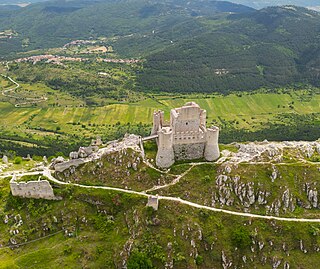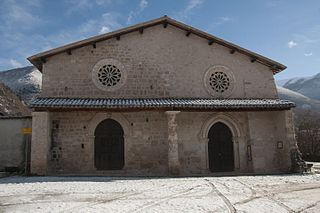
The province of L'Aquila is the largest, most mountainous and least densely populated province of the Abruzzo region of Italy. It comprises about half the landmass of Abruzzo and occupies the western part of the region. It has borders with the provinces of Teramo to the north, Pescara and Chieti to the east, Isernia to the south and Frosinone, Rome and Rieti to the west. Its capital is the city of L'Aquila.

Monte Sant'Angelo is a town and comune of Apulia, southern Italy, in the province of Foggia, on the southern slopes of Monte Gargano. It is one of I Borghi più belli d'Italia.

Atessa is an municipality in the province of Chieti, Abruzzo, south-eastern Italy. It is part of the Val di Sangro mountain community. It is the largest municipality in the province by extension and eighth by population.
Palena is a comune and town in the province of Chieti in the Abruzzo region of Italy.
San Giovanni Teatino is a comune and town in the Province of Chieti in the Abruzzo region of Italy. Until 1894 this comune was known as Forcabobolina. Situated on a hill overlooking the valley of the river Pescara (Aterno-Pescara), in recent years the place has undergone an industrial development, especially in the area of Sambuceto. Abruzzo Airport is also located in a portion of the municipal territory, close to the border with Pescara. In fact, the municipality is virtually divided into two, San Giovanni Teatino (Alto), which is the historic village on the hill, and the aforementioned Sambuceto, an ever-growing urban settlement, home to a large shopping area and an important industrialized area.<>

Torricella Peligna is a comune and town in the Province of Chieti in the Abruzzo region of Italy.

Bugnara is a comune and village in the province of L'Aquila in the Abruzzo region of southern Italy. It is one of I Borghi più belli d'Italia.

Santo Stefano di Sessanio is a comune and hill town in the province of L'Aquila in the Abruzzo region of southern Italy. Located in the Gran Sasso e Monti della Laga National Park, in the highest region of the Apennines, this medieval hill town sits adjacent to the high plain of Campo Imperatore. It is one of I Borghi più belli d'Italia.

Torremaggiore is a town, comune (municipality) and former seat of a bishopric, in the province of Foggia in the Apulia, region of southeast Italy.

Calatabiano is a comune (municipality) in the Metropolitan City of Catania in Sicily, southern Italy.

Torrechiara Castle is a 15th-century castle near Langhirano, in the province of Parma, northern Italy. It sits atop a terraced hill south of the city of Parma, in a strategic position overlooking the Parma River in the valley below. The castle was commissioned by Pier Maria II de' Rossi, the fourth count of San Secondo, and built between 1448 and 1460. The fortress shows the influence of the castles of the House of Sforza, particularly Visconti-Sforza Castle. The castle is managed by the Polo Museale dell'Emilia Romagna since 2015.

The Castle of Rocca Calascio is a mountaintop fortress or rocca in the municipality of Calascio, in the Province of L'Aquila, Abruzzo, Italy.

The 1570 Ferrara earthquake struck the Italian city of Ferrara on November 16 and 17, 1570. After the initial shocks, a sequence of aftershocks continued for four years, with over 2,000 in the period from November 1570 to February 1571.

Palazzo baronale is a fortified palace in Archi, Province of Chieti (Abruzzo).

Castello Franceschelli is a fortified palace in Montazzoli, Province of Chieti (Abruzzo).

Castello Caracciolo is a Middle Ages castle in Tocco da Casauria, Province of Pescara (Abruzzo).

Castello marchesale is a Renaissance castle in Palmoli, Province of Chieti (Abruzzo).

Sant'Agostino is a ruined Roman Catholic church in Amatrice, province of Rieti, Lazio, Italy. It was built in 1428 and it was dedicated to Saint Nicholas, but it was modified over subsequent centuries and rededicated to Saint Augustine of Hippo. Most of the church was destroyed in a series of earthquakes in 2016–17.

San Salvatore, also known as the pieve di Santa Maria, was a Roman Catholic church in Campi, a frazione in the comune of Norcia, Italy. Its existence is first documented in the 11th century, when it was a Benedictine church dedicated to Saint Mary. The church was rebuilt in the 14th century and enlarged in the late 15th century. In 1493, the church was rededicated to the Holy Saviour. The church was an example of Romanesque architecture, and its interior was richly decorated with frescoes. The building collapsed due to damage sustained in the October 2016 Central Italy earthquakes, and only part of the perimeter wall and a pile of rubble survived.



















